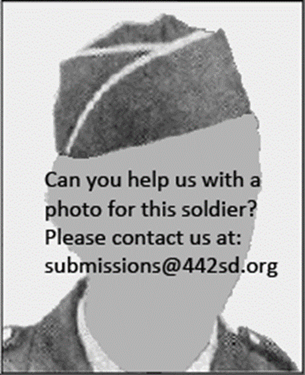
Yoshio Terashima
Technician Fifth Grade
442nd Regimental Combat Team
Cannon Company
Yoshio Terashima was born on November 19, 1918, in Kawailoa, Oahu, Territory of Hawaii. He was one of seven children born to Genji and Hine (Sakata) Terashima. His brothers were Futao, Takashi, and George; his sisters were Betty Chiiko, Amy Eiko, and Ruiko. Genji emigrated in 1907 from Fukushima Prefecture, Japan. Hine emigrated in 1913 from Fukushima Prefecture. They were married on November 14, 1914, in Honolulu. Genji worked for the Waialua Agricultural Company as a carpenter. The family lived in Mill Camp 6, House 36, Waialua.
Yoshio attended Kawailoa Elementary School, and had one year at Waialua High School. He was active in the Young Buddhists Association, and won several championships in ping pong tournaments. He left high school and worked for the Waialua Agricultural Company as a carpenter’s helper.
Yoshio registered for the draft on October 26, 1940, at Local Board No. 11, Waialua Fire Station. He was employed by Turner Construction Company, Kaahumanu and Merchant Streets in Honolulu, as a carpenter’s helper. His point of contact was his father. He was 5’4” tall and weighed 130 pounds.
Yoshio enlisted in the U. S. Army on March 23, 1943. He was sent to Boom Town, the “tent city” at Schofield Barracks where all the recent volunteers were housed. On March 28, they were given an aloha farewell ceremony by the community at Iolani Palace. On April 4, they left on the S.S. Lurline for San Francisco. After arriving in San Francisco, Yoshio and the rest of the new soldiers were sent by train to Camp Shelby, Mississippi, arriving on April 18. He was assigned to the 442nd Regimental Combat Team, Cannon Company.
After a year of basic and specialized training and military exercises, they left by train for Camp Patrick Henry, Virginia, on April 22, 1944. On May 2, the 442nd left nearby Hampton Roads in a convoy of over one hundred ships, and arrived at Naples, Italy, on May 28.
The battalion spent a week at a staging area in Bagnoli, near Naples, before leaving on LSTs for Anzio on June 6, where they marched five miles to a bivouac area. From Anzio, the 442nd went to a large bivouac area near Civitavecchia, north of Rome, where they went through additional training and final preparations for going to the front lines.
The 442nd entered combat on June 26 near Suvereto in the Rome-Arno Campaign. Yoshio, nicknamed “Tera” by his comrades, fought in all battles of the 442nd in Italy. After three months pushing the enemy north to the Arno River, the 442nd was taken off the line to prepare for movement to France. He went with his unit as they were sent to Marseilles, France on September 27 to join in the Rhineland-Vosges Campaign.
Once they arrived in Marseilles, the Combat Team was in a bivouac area in nearby Septèmes until October 9, when they were transported north to participate in the Rhineland-Vosges Campaign. In October-November, the 442nd liberated the important rail and road junction of Bruyères, followed by Belmont and Biffontaine and the famous “Rescue of the Lost Battalion” – the 1st Battalion of the 141st (Texas) Infantry Regiment that had advanced beyond its support, become surrounded by the enemy, and was unable to extricate itself.
Following the vicious fighting in the Vosges, Yoshio went with the 442nd for participation in the Rhineland-Maritime Alps Campaign in southern France. They were in the area of Nice, Menton, and Sospel beginning on November 21. The 442nd returned to Italy on March 25, 1945, for the Po Valley Campaign, leading to the end of the war in May.
For his wartime service, Technician Fifth Grade Yoshio Terashima was awarded the Bronze Star Medal, Good Conduct Medal, American Campaign Medal; European-African-Middle Eastern Campaign Medal with four bronze stars, World War II Victory Medal, Army of Occupation Medal, Combat Infantryman Badge, and Distinguished Unit Badge. He was awarded the Congressional Gold Medal on October 5, 2010, along with the other veterans of the 100th/442nd Regimental Combat Team. This is the highest Congressional Civilian Medal.
Yoshio returned home to Hawaii on December 17, 1945, on the USAT Aconcagua, arriving at 8:30 a.m. to Pier 26. He was one of 551 veterans aboard the ship. Hundreds of families and friends gathered to greet the soldiers; however, they were quickly put on buses that took them to the Army Separation Center at Fort Kamehameha. Later in the day, they were given passes and were to return in a few days for discharge from the Army. The Army had announced that access to Fort Kamehameha was not restricted and anyone going there in search of their returning veteran would be given assistance in finding him. He was discharged on December 22, 1945.
Yoshio married Clara Fujie Kagehiro and they raised two daughters. He worked as a carpenter in Mililani. He was a member of the Wahiawa Soto Mission.
Yoshio died on October 19, 1999, in Mililani, and was buried in Mililani Memorial Park. Clara had preceded him; she died in 1996. They are buried together.
His brother, Futao Terashima, served as a Private First Class in the 442nd Regimental Combat Team, 3rd Battalion, I Company.
Researched and written by the Sons & Daughters of the Regimental Combat Team in 2022.
